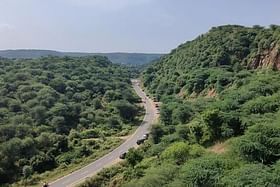The ‘Green Wall’ will cover roughly a 1,400-km-long and a 5-km-wide green belt buffer around the mountain range, with its expanse in parts of Gujarat, Rajasthan, Haryana and Delhi.
The Haryana government on 25 March launched an extensive afforestation and plantation project called the “Green Wall”, which will spread across 75 villages.
The project is aimed to revive the Aravalli range along with providing multiple ecological benefits for the surrounding regions.
The project was inaugurated by Union Minister for Environment, Forest and Climate Change Bhupender Yadav in village Tikli, located 13 km from Gurugram.
The idea for creation of the green belt has been conceptualised on the lines of the African Green Wall programme, an initiative launched in Sahel, the region bordering Africa’s Sahara Desert, to increase the amount of arable land.
The Aravallis are the oldest mountain range in India stretching diagonally from southwest Gujarat to Rajasthan up to Delhi and Haryana.
Aravalli As Green Barrier
For the cities of Gurugram and Delhi, the Aravalli range serve as a natural barrier against the relentless eastward march of the desert, a process called desertification.
Additionally, it remains a vital ecological zone — serving as a lung space, attempting to balance the polluted air of the capital region, while also function as a groundwater recharge zone for the regions.
However, the unregulated development and changes in land use with deforestation, rampant mining, dumping of waste and encroachments, have had a significant impact on its ecology and biodiversity.
The groundwater levels in Gurugram and surroundings have also depleted to its lowest over the years of the regions’ rapid expansion.
According to the 2016 desertification and land degradation atlas of India, published by ISRO — Gujarat, Rajasthan, and Delhi stood among the regions where over 50 per cent of the total area was categorised as degraded land and faced the risk of desertification.
As per reports, the Aravali range has been identified as one of the key degraded zones to be taken up for greening under India’s target to restore 26 million hectares of its land.
The Proposed Green Wall
The Green Wall will cover roughly a 1,400-km-long and a 5-km-wide green belt buffer around the mountain range, with its expanse in parts of Gujarat, Rajasthan, Haryana and Delhi.
The ambitious project will involve planting native species of trees and shrubs on scrubland, wasteland and degraded forest land, along with rejuvenating and restoring surface waterbodies such as ponds, lakes and streams.
The 5 km buffer zone covers 6.3 million hectares (Mha) of land, of which 2.3 Mha is currently degraded, reports Times of India.
Almost all of this degraded land area is aimed to be restored through this green belt project.
According to the State Forest Department officials, they will earmark 18,000 hectares of area in Gurugram, 5,000 hectares in Faridabad, 1,000 hectares in Bhiwani, 6,000 hectares in Mahendergarh and 5,000 hectares in Rewari for the project, as per a report by Hindustan Times.
With this, the total area covered in Haryana will be part of the project to revive the Aravallis, that stand as the only barrier stopping the expansion of desert land towards north-west India, stated Union Minister Bhupender Yadav.
The forests in the suggested green belt will not only prevent the eastward advancement of the Thar Desert, but also serve as a green barrier against the dust that originates from the western side of the country to the National Capital Region (NCR).
The Union Minister explained that the Green Wall project will not only increase the green cover and biodiversity of the range through afforestation and restoration of water bodies, but also improve soil fertility, water availability and climate resilience of the region.
“The project will benefit the local communities by providing them with employment opportunities, income and ecosystem services,“ Yadav said, reiterating the government’s commitment to achieve the national goal of creating an additional 2.5 billion tonnes of carbon sink by 2030.
On the launch of this project, Gurugram deputy commissioner Nishant Kumar Yadav said, “It will act as a shield to Aravalli flora and fauna. The project will include plantation of indigenous plants in the foothills of Aravallis.“
He added that local citizens will be roped in to take ownership of these plantations. We will also rejuvenate ponds in the foothills under the Amrit Sarovar scheme, to supplement the plantation.
Further, 75 reservoirs would be developed to encourage greenery in five districts. It will also focus on agro-forestry and pasture development to enhance the livelihoods of local communities.
Forest officials added that the plantation will be taken up in five villages each in Nuh, Gurugram, Rewari, Narnaul and Faridabad districts.


